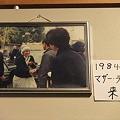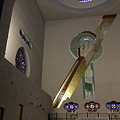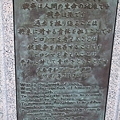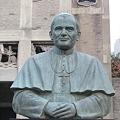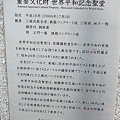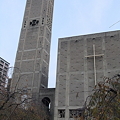Pope John Paul II
- 402
Pope John Paul II http://on.fb.me/tDlxd3
教皇ヨハネ・パウロ2世
From the Appeal for Peace Pope John Paul II
War is the work of man.
War is destruction of human life.
War is death.
To remember the past is to commit oneself to the future.
To remember Hiroshima is to abhor nuclear war.
To remember Hiroshima is to commit oneself to peace.
On February 25 1981, Pope John Paul II visited Hiroshima and made his world famous Appeal for Peace.
In front of the Cathedral stands a bronze statue of the Pope as a lasting remembrance.
To remember the past is to commit oneself to the future.
To remember Hiroshima is to abhor nuclear war.
To remember Hiroshima is to commit oneself to peace.
To remember what the people of this city suffered is to renew our faith in man, in his capacity to do what is good, in his freedom to choose what is right, in his determination to turn disaster into a new beginning.
In the face of the man-made calamity that every war is, one must affirm and reaffirm, again and again, that the waging of war is not inevitable or unchangeable.
Humanity is not destined to self-destruction.
Clashes of ideologies, aspirations and needs can and must be settled and resolved by means other than war and violence.
Humanity owes it to itself to settle difference and conflicts by peaceful means.
The great spectrum of problems facing the many peoples in varying stages of cultural, social, economic and political development gives rise to international tension and conflict. It is vital for humanity that these problems should be solved in accordance with ethical principles of equity and justice enshrined in meaningful agreements and institutions.
The international community should thus give itself a system of law that will regulate international relations and maintain peace, just as the rule of law protects national order.
Memorial Cathedral for World Peace
世界平和記念聖堂
広島市中区幟町4-42
4-42 Nobori-machi, Naka-ku, Hiroshima, Hiroshima, Japan
The Dedication of the Cathedral
On 6 August 1945, within minutes of the flash of the Atomic Bomb, Hiroshima was engulfed in flames. Tens of thousands of people died; World War II ended.
A Jesuit missionary, the Reverend Hugo Lassalle, was pastor of the parish at Noboricho located less than 1500 meters from the hypocenter of the bomb. Although wounded vritically, he survived.
As he turned to the task of rebuilding his church, he gegan to think of it as a monument to World Peace, thrusting its tower to heaven from the charred heart of Hiroshima. It would be a Cathedral dedicated to the memory of the Atomic Bomb victims, a symbol of love and peace for all nations.
In September 1946 when Father Lassalle went to Rome for an audience with His Holiness Pope Pius XII, he disclosed his dream of a Peace Cathedral in Hiroshima.
With the Pope’s blessing he set about soliciting funds from Europe, America, and from all over the world. The counstruction begun on 6 August 1950 was completed by 6 August 1954. The Cathedral now stands as a symbol of hope, dedicated to World Peace built by the people of the world who yearn for peace, an earnest expression of love and giving that has transcended race, creed, and nationality.
Data on the structure of the Building
Type of construction: reinforced concrete-steel construction
Ground area: 1230sqm. 1492sqyds
Length(total): 52.50m. 173ft.
Width(total): 20.00m. 66ft.
Height: dome(inside) 26.40m. 88ft.
dome(outside) 28.00m. 93ft.
tower 45.00m. 150ft.
Special Donations
Main Altar (Belgium)
Tabernacle (City of Bonn)
Communion Rail (Bavaria)
Baptistery (City of Aachen)
Bronze doors (City of Dusseldorf)
Grill of entrance and behind main altar (Westfalia)
Pipe organ (City of Cologne)
Four church bells (Bochumer Verein)
Church windows behind main altar (St. Ludwigs Missionverein, Munich)
Rose windows (Francis Xavier Verein, Aachen)
Stations of the Cross (City of Munster)
Large carved wooden Crucifix (City of Oberammergau)
Mosaic behind main altar (Former Chancellor of West Germany, Konrad Adenauer)
Church windows of the 15 mysteries of the Rosary (Various places of pilgrimage of the Blessed Virgin in Germany, Portugal, Mexico and other countries)
The 14 church windows in the Nave (Austria)
Tabernacle in the crypt (Spain)
タグ: (haq)qōdheš Aachen Adenauer Agnesa/Antigona Agnesë architecture Ark BELCA賞 Belgien Belgique België Bochum Boiagi Bojaxhiu Bonn Cathedral de Enomiya-Lassalle Eugenio Externbrock for Fènghuáng Giovanni Giuseppe Gongea Gonxhe Gothic Hermann Hiroshima Hugo II Ioannes Jan John Joseph Juan Koninkrijk Konrad Köln Königreich Makibi Maria Memorial Minga Modernism Mother München Münster Pablo Pacelli Paolo Papa Paul Paulus Paweł Peace Pertual Pius Portuguesa RC造 Romanesque Royaume Teresa World XII ărōn イエズス会 カテドラル カトリック幟町教会 キリスト教 ゴシック建築 セミ・モノコック構造 ドイツ人 ピウス12世 ピオ12世 フーゴ・マキビ・エノミヤ=ラッサール フーゴ・ラッサール マザー・テレサ モダニズム建築 ヨゼフ ヨハネ・パウロ2世 ロマネスク建築 愛宮真備 吉田茂 教会堂 教皇 広島市 広島市中区 広島平和記念聖堂建設後援会 広島平和記念都市建設法 広島名誉市民 高松宮宣仁親王 国指定重要文化財 三末篤實 三廊式バシリカ 山田節夫 司教 司教座聖堂 主任司祭 重要文化財 世界平和記念聖堂 清水建設 聖櫃 石丸紀興 村野・森建築事務所 村野藤吾 大聖堂 第264代ローマ教皇 丹下健三 池田勇人 鉄筋コンクリート造 内藤多仲 南和夫 平和記念広島カトリック聖堂建築競技設計 鳳凰 歴史主義建築 幟町148番地 幟町天主公教会
お気に入り (0)
まだお気に入りに追加している人はいません。
コメント (0)
まだコメントがありません。最初のコメントを書いてみませんか?
コメントするにはログインが必要です。フォト蔵に会員登録(無料)するとコメントできます。

